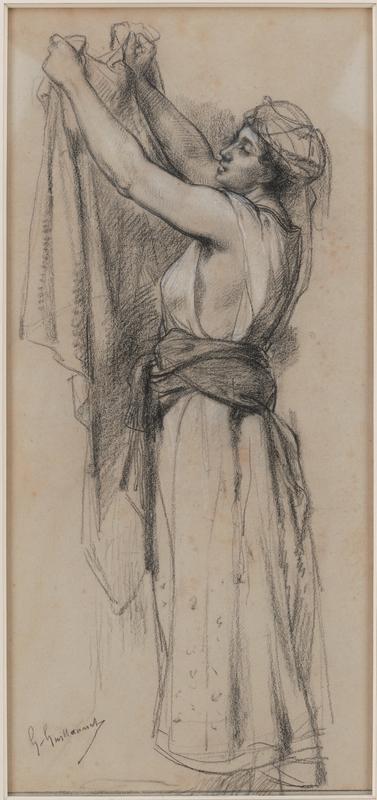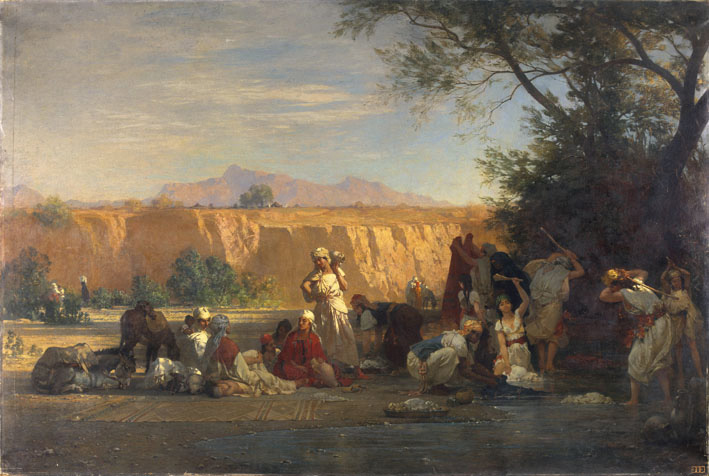
79. Gustave Achille Guillaumet, Moorish Woman, Study for “The Women of the Douar at the River”
| Artist | Gustave Achille Guillaumet, French, Paris 1840–Paris 1887 |
| Title, Date | Moorish Woman, Study for “The Women of the Douar at the River”, c. 1872 |
| Medium | Charcoal and white chalk |
| Dimensions | 23 7/16 × 10 11/16 in. (59.6 × 27.2 cm) |
| Inscriptions + Marks | Lower left: G. Guillaumet |
| Provenance | [Daniel Delétrain, Marché Serpette, Clignancourt, until 2009; to Weisberg]; Yvonne and Gabriel Weisberg, Minneapolis |
| Exhibition History | Possibly in Peintures, aquarelles, dessins et sculptures du XIX siècle, Galerie Jean-François et Philippe Heim, Paris, 1986; "Reflections on Reality: Drawings and Paintings from the Weisberg Collection," Mia, 2022–23 |
| Credit Line | Promised gift of Gabriel P. and Yvonne M.L. Weisberg, Minneapolis |
An important figure among the so-called Orientalist painters in the late nineteenth century, Gustave Guillaumet was a well-respected presence at the Paris Salons. For most of his paintings, he made a number of preliminary drawings. This sketch of a woman holding an upraised garment is a study for The Women of the Douar at the River (Les femmes du Douar à la rivière), an oil shown at the Salon of 1872 and now in the collection of the Musée des Beaux-Arts in Dijon (fig. 1).1 Far more than travelogue scenes, Guillaumet’s Orientalist images of Algeria and Morocco are often naturalist renditions of the daily life he witnessed, aided by practical tools and techniques. In Algeria, for example, which was colonized by France in the 1830s, he drew his models in situ, posed them carefully, and took photographs, perhaps to aid his memory and confirm accuracy when finishing the painting.2

In this sheet, Guillaumet showed the figure with no hint of her surroundings. His interest lay with her activity rather than her placement in the composition. In the subsequent painting, she appears in the shade toward the back, one of many figures washing clothes in a river while others in the party sit and converse. When Guillaumet died at age forty-seven, he left behind many such paintings; he was one of the first European artists to spend time in Algeria, and one of the most sensitive. The douar in the painting’s title means “circle” among some Bedouin people, referring to tents grouped in a circle next to other family members, or an encampment arranged around an open space. In the 1870s, the French colonizers used douar to designate administrative areas of the countryside.3
GPW
Notes
The painting is reproduced in the catalogue L’Algérie de Gustave Guillaumet (1840–1887), presented at the Musée des Beaux-Arts de la Rochelle, the Musée des Beaux-Arts de Limoges, and La Piscine–Musée d’art et d’industrie André Diligent de Roubaix (Montreuil: Éditions Gourcuff Gradenigo, 2018), pp. 138–39. ↩︎
See Michel Mégnin, “Guillaumet et la photographie” in L’Algérie de Gustave Guillaumet (2018), pp. 99–107. ↩︎
See Hugh Roberts, Berber Government: The Kabyle Polity in Pre-colonial Algeria (London and New York: I. B. Tauris, 2014), p. 121. ↩︎